I have a collection of images as below -
Example 1

Example 2

Example 3

These represent dates in DDMMYYYY format. For each of these images, I want to save each digit as a separate image.For example 1, I wish to save 7,9,0,8,5,8,7,1 as separate images sliced from the original image. So far, I have tried various methods described on different stackoverflow & blogposts but none of them seems to work.
Code to extract boxes surrounding dates -
from glob import glob
import cv2 as cv
import numpy as np
from tqdm import tqdm
class ExtractRectangle:
def __init__(self):
super().__init__()
self.minLinLength_h = 70
self.minLinLength_v = 5
self.maxLineGap = 20
def is_horizontal(self, line, thresh=5):
return abs(line[1] - line[3]) <= thresh
def is_vertical(self, line, thresh=5):
return abs(line[0] - line[2]) <= thresh
def get_lines(self, canny, horizontal=True):
lines = []
if horizontal:
linesP = cv.HoughLinesP(
canny,
rho=1,
theta=np.pi / 180,
threshold=10,
lines=None,
minLineLength=self.minLinLength_h,
maxLineGap=20,
)
else:
linesP = cv.HoughLinesP(
canny,
rho=1,
theta=np.pi / 180,
threshold=10,
lines=None,
minLineLength=self.minLinLength_v,
maxLineGap=20,
)
if linesP is not None:
for i in range(0, len(linesP)):
l = linesP[i][0]
if self.is_horizontal(l, 3) and horizontal:
lines.append(l)
elif self.is_vertical(l, 3):
lines.append(l)
return lines
def remove_whitespace(self, img):
# https://stackoverflow.com/questions/48395434/how-to-crop-or-remove-white-background-from-an-image
gray = cv.cvtColor(img, cv.COLOR_BGR2GRAY)
th, threshed = cv.threshold(gray, 127, 255, cv.THRESH_BINARY_INV)
kernel = cv.getStructuringElement(cv.MORPH_ELLIPSE, (11, 11))
morphed = cv.morphologyEx(threshed, cv.MORPH_CLOSE, kernel)
cnts = cv.findContours(morphed, cv.RETR_EXTERNAL, cv.CHAIN_APPROX_SIMPLE)[-2]
cnt = sorted(cnts, key=cv.contourArea)[-1]
x, y, w, h = cv.boundingRect(cnt)
dst = img[y : y + h, x : x + w]
return dst
def process_image(self, filename, path):
errenous = False
img = cv.imread(cv.samples.findFile(filename))
img = self.remove_whitespace(img)
cImage = np.copy(img)
gray = cv.cvtColor(img, cv.COLOR_BGR2GRAY)
canny = cv.Canny(gray, 100, 200)
horizontal_lines = self.get_lines(canny)
horizontal_lines = sorted(horizontal_lines, key=lambda a_entry: a_entry[..., 1])
vertical_lines = self.get_lines(canny, horizontal=False)
vertical_lines = sorted(vertical_lines, key=lambda a_entry: a_entry[..., 0])
if len(horizontal_lines) > 0:
initial_line = horizontal_lines[0]
final_line = horizontal_lines[-1]
# LeftTop(x1, y1) -> RightTop(x2, y1) -> RightBottom(x2, y2) -> LeftBottom(x1, y2)
y1 = initial_line[1]
y2 = final_line[1]
bottom = min(y1, y2)
top = max(y1, y2)
# post whitespace removal, dates should only be the major component
if (top-bottom) / img.shape[0] < 0.6:
errenous = True
else:
errenous = True
if len(vertical_lines) > 0:
initial_line = vertical_lines[0]
final_line = vertical_lines[-1]
x1 = initial_line[0]
x2 = final_line[0]
left = min(x1, x2)
right = max(x1, x2)
# as dates occupy majority of the horizontal space
if (right-left) / img.shape[1] < 0.95:
errenous = True
else:
errenous = True
if not errenous:
# cImage = cv.rectangle(cImage, (left, bottom), (right, top), (255, 0, 0), 2)
cImage = cImage[
bottom : bottom + (top - bottom), left : left + (right - left)
]
cv.imwrite(f"{path}/{filename.split('/')[-1]}", cImage)
if __name__ == "__main__":
extract = ExtractRectangle()
test_files = glob("data/raw/test/*.png")
test_path = "data/processed/test/"
for path in tqdm(test_files):
extract.process_image(path, test_path)
train_files = glob("data/raw/train/*.png")
train_path = "data/processed/train/"
for path in tqdm(train_files):
extract.process_image(path, train_path)
Resultant detection for above images -
Example 1

Example 2

Example 3

Some other samples
